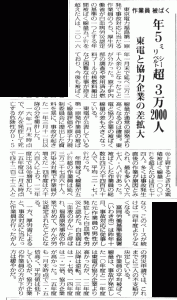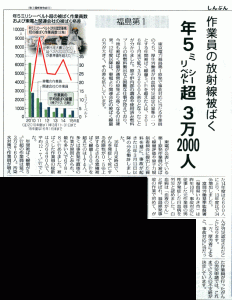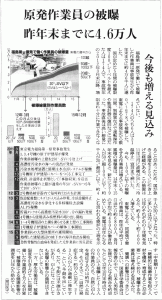Original Japanese written by staffer
The English below written and arranged by Heeday, based on the original Japanese
The English edited by Rev. Dr. Henry French, ELCA
Articles from the March 7th, 2016 editions of the Fukushima Minpo and Akahata newspapers and from the March 9th edition of the Asahi Shimbun newspaper)
Fukushima Daiichi workers facing fatal risks
Of the workers counteracting the meltdown at TEPCO’s Fukushima Daiichi, a total of more than 32,000 have been exposed to 5 mSv or more of radiation, as of the end of January 2016, according to a recent finding. 5 mSv is the criterion set up by Japan’s Ministry of Health, Labour and Welfare for registering a worker as a victim of work-related leukemia. Anyone can tell that those workers will be exposed to even more radiation in the months to come than workers at other nuclear power plants, since they have highly dangerous jobs to do, such as inspecting the reactors’ insides, carrying used nuclear fuels out of the storage pools, etc. Since 2012, employees of TEPCO’s subsidiaries and subcontractors have been exposed to more radiation than TEPCO’s own employees have. And this gap has been ever expanding.
“Deadly dangerous — you go first”
Yet another fact discovered is that those non-TEPCO workers, who come to Fukushima Daiichi from TEPCO’s subcontractors and subsidiaries, have been exposed to radiation almost 4 times greater than the overall average exposure. Since almost 90% of all the workers are from outside TEPCO, their total exposure dose together reached some 30 times above the average. This is obvious evidence that the power company pushes more dangerous jobs to non-TEPCO workers.
Needed yet mistreated
Ever since Fukushima Daiichi began to melt down, countless workers have come and gone. Especially, in those areas with high radiation, many workers reach their legal limit of accumulative exposure in only three months of work or so and leave the nuclear power plant (NPP). Furthermore, those workers, exposed to all the dangers, are not receiving compensation worthy of their risks. On the average, they receive only JPY 200,000 or so, which is below what some of the decontamination workers outside the NPP receive. Thus, many NPP workers are voicing their dissatisfaction. Now, experts say that decommissioning Fukushima Daiichi will take four decades or so. Where can a sufficient workforce come from to handle 40 years of highly dangerous work?
In conclusion
Fukushima Daiichi is currently cooled and quiet, but only because workers there are risking their health and lives to keep it cooled. All of us must show our gratitude and respect to them.
At the same time, the Japanese government should establish a decent compensation system for all those workers who risk their own health to save the rest of us. Such a compensation system should cover the years following those workers’ retirements as well.



